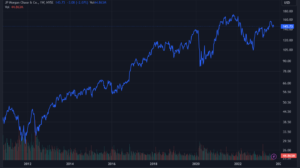India is set to receive a huge boost in foreign investments as JP Morgan, one of the world’s largest investment banks, has announced that it will include Indian bonds in its Emerging Markets bond index from June 2024. This is a historic milestone for India, as it will open up a large pool of global capital for its bond market, which will have positive implications for its currency, economy, and equity market.
Who is JP Morgan and what is its Emerging Markets bond index?
JP Morgan is an American multinational investment bank and financial services company that operates in more than 100 countries. It is one of the most influential and respected financial institutions in the world, with a market capitalization of over $500 billion. It offers various products and services to its clients, such as asset management, commercial banking, investment banking, private banking, securities services, and wealth management.

One of the products that JP Morgan offers is its Emerging Markets bond index, which is a widely used benchmark for measuring the performance of bonds issued by emerging market countries. The index covers sovereign and quasi-sovereign bonds denominated in US dollars, euros, or local currencies. The index has several sub-indices, such as the EMBI Global Diversified (EMBIGD), which tracks the most liquid and accessible bonds in the emerging markets.
The EMBIGD index currently includes 74 countries and has around $230 billion in assets under management (AUM) tracking it. However, active flows are expected to closely mirror passive flows, and this trend is anticipated to continue. The index is widely followed by investors, traders, analysts, and policymakers around the world, as it reflects the risk and return characteristics of the emerging markets bond universe.
Why is India’s inclusion in the index a big deal?
India’s inclusion in the EMBIGD index is a big deal because it means that India will become more visible and attractive to global investors who are looking for exposure to emerging markets. India will have a maximum weight of 10% in the index, which is equivalent to around $23 billion in potential passive inflows. However, this could be much higher if active investors also increase their allocations to India.
“India’s weight is expected to reach the maximum weight threshold of 10% in the GBI-EM Global Diversified, and approximately 8.7% in the GBI-EM Global index,” JPMorgan said.
To put this in perspective, the highest net foreign inflow into Indian bonds in 2014 was approximately $26 billion, while year-to-date inflows as of September 20 stand at around $3.5 billion, indicating significant future potential. Moreover, India’s inclusion in the index will also pave the way for its inclusion in other major EM bond indices, such as FTSE EM bond index and Bloomberg Barclays EM bond index, which have similar AUMs tracking them. This could result in total flows of at least $40-50 billion in the medium term (6-12 months) if Indian government bonds (IGBs) get included in all three indices.
“Considering this, we can estimate total flows to be at least $40-50 billion in the medium term (6-12 months) if IGBs get included in all three indices. This is a significant number because not only it provides an alternative source of financing for government borrowings, it opens up the space for corporate issuers as well as bringing the entire yield curve down significantly once all the inclusions are in place”, said Satyakam Gautam, Rates trader, ICICI Bank on its LinkedIn profile.
What are the benefits of India’s inclusion in the index?
India’s inclusion in the EMBIGD index will have several benefits for its bond market, currency market, economy, and equity market. Some of the benefits are:
- Increased foreign exchange inflows: India’s inclusion in the index will increase the demand for Indian rupees from foreign investors who want to buy Indian bonds. This will support the Indian rupee and help offset the pressure from rising oil prices and a widening current account deficit. A stable and strong rupee will also reduce the cost of imports and external debt servicing for India.
- Lower borrowing costs: India’s inclusion in the index will increase the supply of funds for government borrowings, which will reduce the yield on Indian bonds. This will lower the borrowing costs for the government as well as for corporate issuers who can benefit from lower interest rates. Lower interest rates will also stimulate economic growth and investment.
- Diversified investor base: India’s inclusion in the index will broaden the investor base for Indian bonds, as more global investors will participate in the market. This will enhance liquidity and demand diversification for Indian bonds, which will improve market efficiency and stability.
- Improved economic fundamentals: India’s inclusion in the index will positively impact its economic fundamentals, such as fiscal deficit, inflation, growth, and credit rating. A more disciplined fiscal policy, lower inflationary pressures, higher growth prospects, and better credit ratings will make Indian assets more attractive to domestic and foreign investors alike.
What are the challenges and risks of India’s inclusion in the index?
India’s inclusion in the EMBIGD index also comes with some challenges and risks that need to be addressed by the authorities. Some of the challenges and risks are:
- Regulatory reforms: India’s inclusion in the index requires some regulatory reforms to make its bond market more accessible and transparent for foreign investors. For instance, India needs to remove the caps on foreign portfolio investment (FPI) in Indian bonds, simplify the registration and reporting process for FPIs, harmonize the taxation and withholding rules for FPIs, and enhance the market infrastructure and settlement system for bond transactions.
- Market volatility: India’s inclusion in the index exposes its bond market to global market volatility, as foreign investors may react to changes in global risk appetite, interest rates, exchange rates, and geopolitical events. This may cause sudden and large inflows or outflows of capital, which may create volatility and uncertainty in the bond market. The authorities need to monitor and manage the capital flows and intervene when necessary to maintain market stability.
- Fiscal responsibility: India’s inclusion in the index increases fiscal responsibility for the government, as foreign investors will closely watch its fiscal decisions and performance. The government needs to maintain a credible and sustainable fiscal policy that balances growth and stability, while avoiding excessive borrowing and spending. The government also needs to improve the quality and efficiency of public expenditure and revenue collection, and implement structural reforms to boost productivity and competitiveness.
Conclusion
India’s inclusion in the JP Morgan’s EMBIGD index is a landmark achievement for its bond market, as it will attract significant foreign investments that will have positive spillover effects for its currency market, economy, and equity market. However, India also needs to address some challenges and risks that come with its inclusion in the index, such as regulatory reforms, market volatility, and fiscal responsibility. India has a great opportunity to leverage its inclusion in the index to enhance its global profile and reputation as an attractive investment destination.

